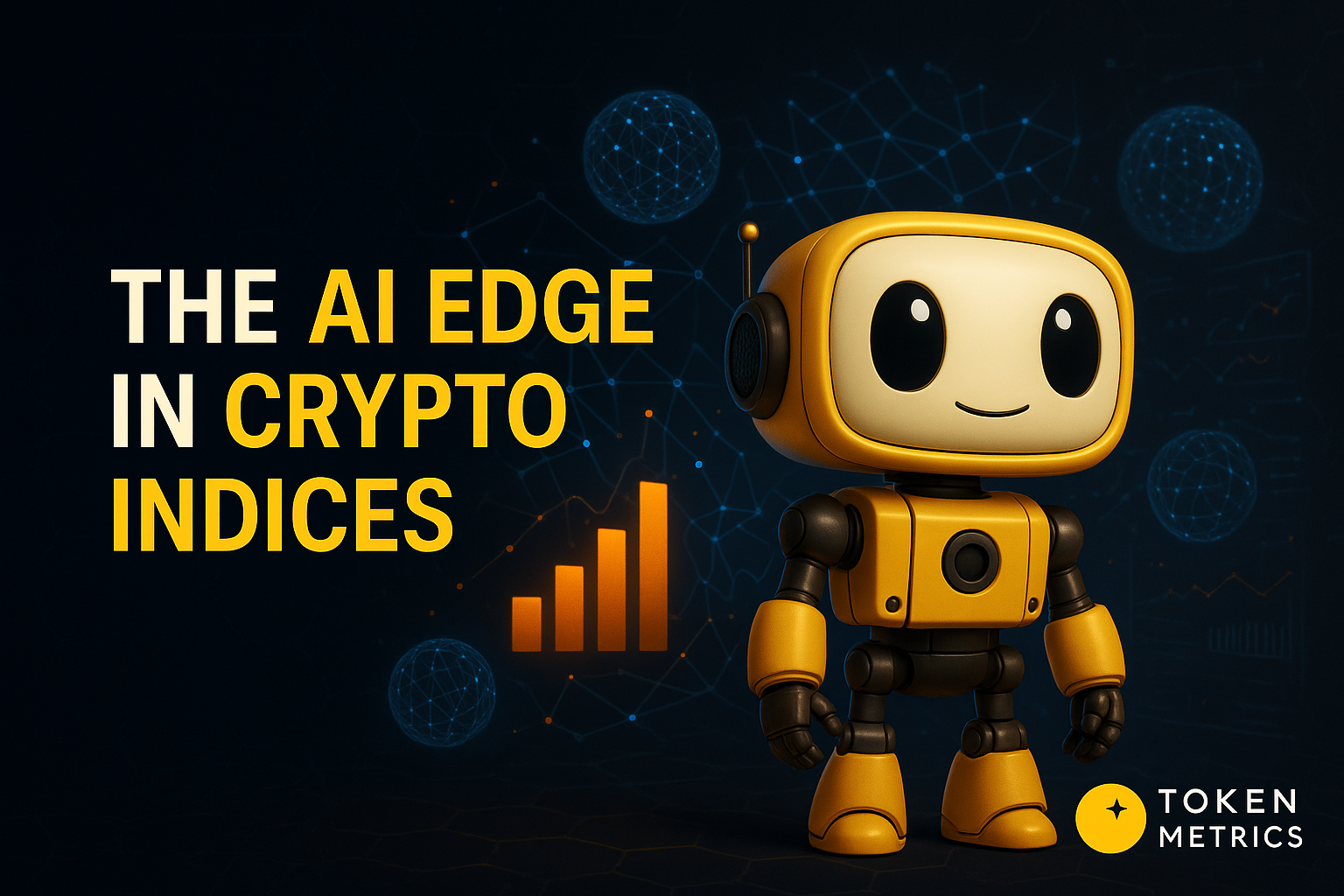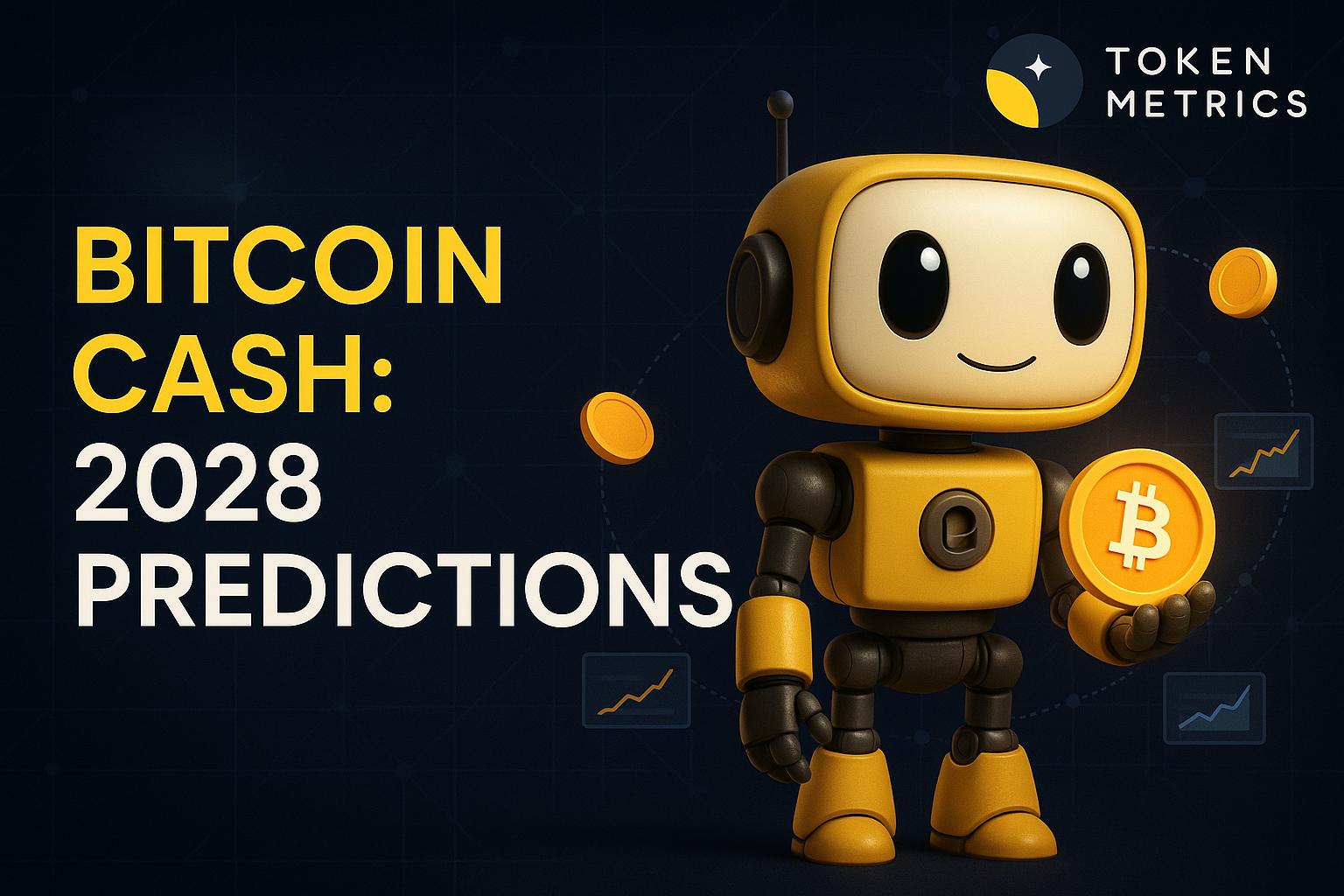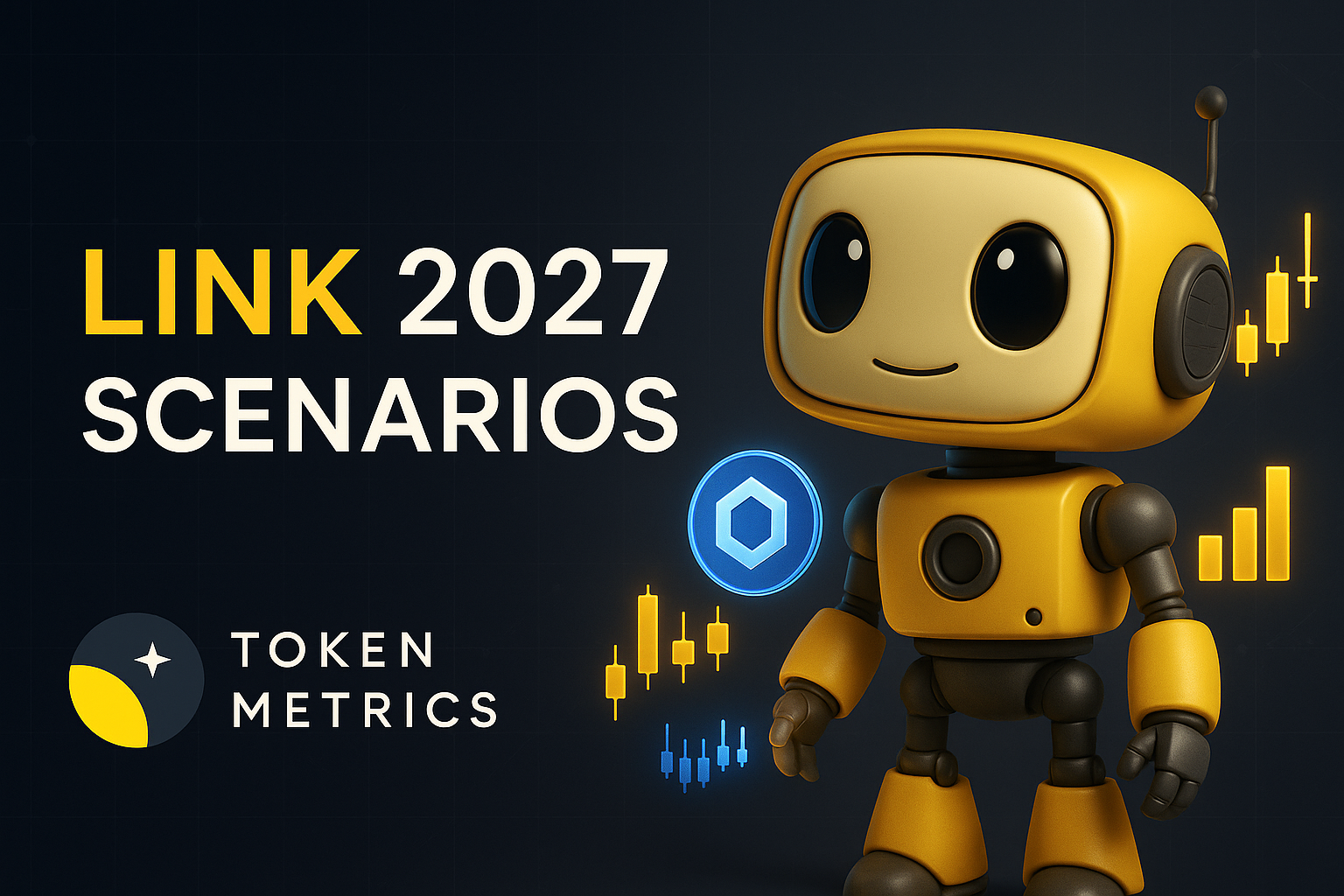Top Crypto Trading Platforms in 2025







%201.svg)
%201.svg)
Big news: We’re cranking up the heat on AI-driven crypto analytics with the launch of the Token Metrics API and our official SDK (Software Development Kit). This isn’t just an upgrade – it's a quantum leap, giving traders, hedge funds, developers, and institutions direct access to cutting-edge market intelligence, trading signals, and predictive analytics.
Crypto markets move fast, and having real-time, AI-powered insights can be the difference between catching the next big trend or getting left behind. Until now, traders and quants have been wrestling with scattered data, delayed reporting, and a lack of truly predictive analytics. Not anymore.
The Token Metrics API delivers 32+ high-performance endpoints packed with powerful AI-driven insights right into your lap, including:
Getting started with the Token Metrics API is simple:
At Token Metrics, we believe data should be decentralized, predictive, and actionable.
The Token Metrics API & SDK bring next-gen AI-powered crypto intelligence to anyone looking to trade smarter, build better, and stay ahead of the curve. With our official SDK, developers can plug these insights into their own trading bots, dashboards, and research tools – no need to reinvent the wheel.
%201.svg)
%201.svg)
The Layer 1 landscape is consolidating as users and developers gravitate to chains with clear specialization. Bitcoin Cash positions itself as a payment-focused chain with low fees and quick settlement for everyday usage.
The scenario projections below map potential outcomes for BCH across different total crypto market sizes. Base cases assume steady usage and listings, while moon scenarios factor in stronger liquidity and accelerated adoption.
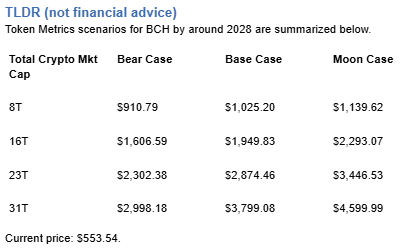
Disclosure
Educational purposes only, not financial advice. Crypto is volatile, do your own research and manage risk.
How to read it: Each band blends cycle analogues and market-cap share math with TA guardrails. Base assumes steady adoption and neutral or positive macro. Moon layers in a liquidity boom. Bear assumes muted flows and tighter liquidity.
TM Agent baseline:
Token Metrics lead metric for Bitcoin Cash, cashtag $BCH, is a TM Grade of 54.81%, which translates to Neutral, and the trading signal is bearish, indicating short-term downward momentum. This implies Token Metrics views $BCH as mixed value long term: fundamentals look strong, while valuation and technology scores are weak, so upside depends on improvements in adoption or technical development. Market context: Bitcoin has been setting market direction, and with broader risk-off moves altcoins face pressure, which increases downside risk for $BCH in the near term.
Live details:
Affiliate Disclosure: We may earn a commission from qualifying purchases made via this link, at no extra cost to you.
Token Metrics scenarios span four market cap tiers, each representing different levels of crypto market maturity and liquidity:
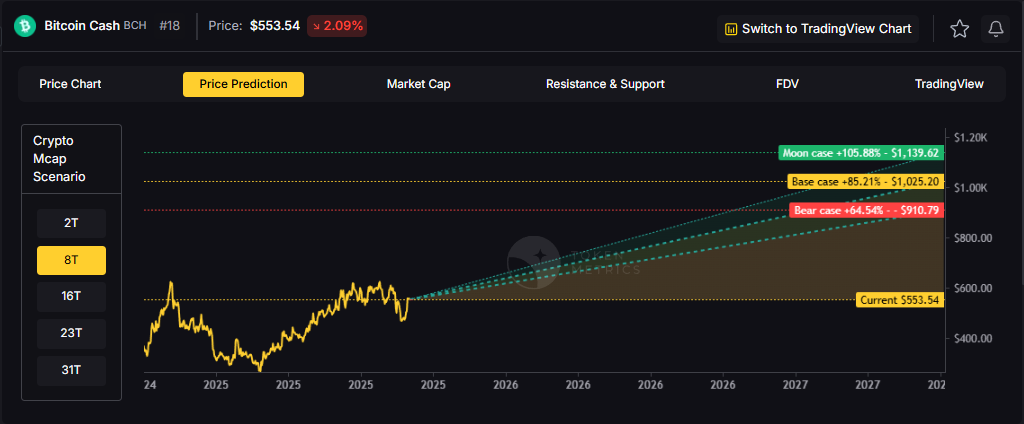


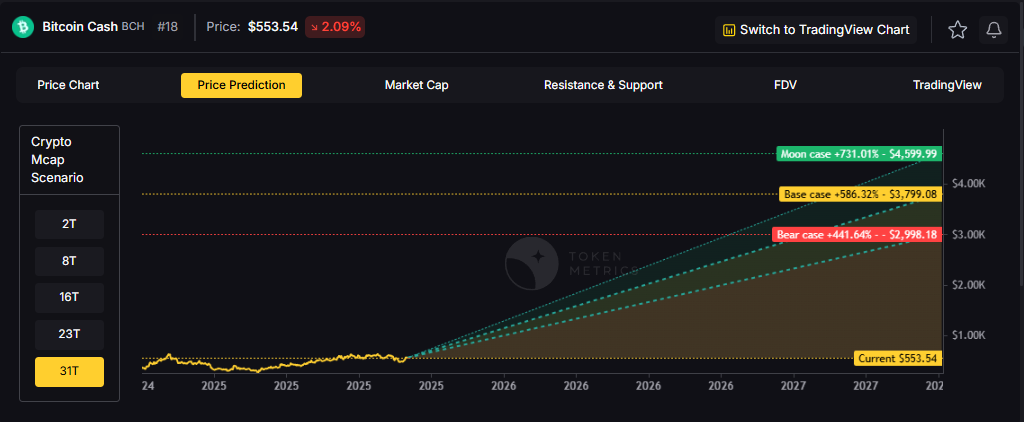
Each tier assumes progressively stronger market conditions, with the base case reflecting steady growth and the moon case requiring sustained bull market dynamics.
Bitcoin Cash represents one opportunity among hundreds in crypto markets. Token Metrics Indices bundle BCH with top one hundred assets for systematic exposure to the strongest projects. Single tokens face idiosyncratic risks that diversified baskets mitigate.
Historical index performance demonstrates the value of systematic diversification versus concentrated positions.
Bitcoin Cash is a peer-to-peer electronic cash network focused on fast confirmation and low fees. It launched in 2017 as a hard fork of Bitcoin with larger block capacity to prioritize payments. The chain secures value transfers using proof of work and aims to keep everyday transactions affordable.
BCH is used to pay transaction fees and settle transfers, and it is widely listed across major exchanges. Adoption centers on payments, micropayments, and remittances where low fees matter. It competes as a payment‑focused Layer 1 within the broader crypto market.
Token Metrics AI provides comprehensive context on Bitcoin Cash's positioning and challenges.
Vision:
Bitcoin Cash (BCH) is a cryptocurrency that emerged from a 2017 hard fork of Bitcoin, aiming to function as a peer-to-peer electronic cash system with faster transactions and lower fees. It is known for prioritizing on-chain scalability by increasing block sizes, allowing more transactions per block compared to Bitcoin. This design choice supports its use in everyday payments, appealing to users seeking a digital cash alternative. Adoption has been driven by its utility in micropayments and remittances, particularly in regions with limited banking infrastructure. However, Bitcoin Cash faces challenges including lower network security due to reduced mining hash rate compared to Bitcoin, and ongoing competition from both Bitcoin and other scalable blockchains. Its value proposition centers on accessibility and transaction efficiency, but it operates in a crowded space with evolving technological and regulatory risks.
Problem:
The project addresses scalability limitations in Bitcoin, where rising transaction fees and slow confirmation times hinder its use for small, frequent payments. As Bitcoin evolved into a store of value, a gap emerged for a blockchain-based currency optimized for fast, low-cost transactions accessible to the general public.
Solution:
Bitcoin Cash increases block size limits from 1 MB to 32 MB, enabling more transactions per block and reducing congestion. This on-chain scaling approach allows for faster confirmations and lower fees, making microtransactions feasible. The network supports basic smart contract functionality and replay protection, maintaining compatibility with Bitcoin's core architecture while prioritizing payment utility.
Market Analysis:
Bitcoin Cash operates in the digital currency segment, competing with Bitcoin, Litecoin, and stablecoins for use in payments and remittances. While not the market leader, it occupies a niche focused on on-chain scalability for transactional use. Its adoption is influenced by merchant acceptance, exchange liquidity, and narratives around digital cash. Key risks include competition from layer-2 solutions on other blockchains, regulatory scrutiny of cryptocurrencies, and lower developer and miner activity compared to larger networks. Price movements are often tied to broader crypto market trends and internal protocol developments. Despite its established presence, long-term growth depends on sustained utility, network security, and differentiation in a market increasingly dominated by high-throughput smart contract platforms.
Fundamental Grade: 80.41% (Community 62%, Tokenomics 100%, Exchange 100%, VC —, DeFi Scanner 72%).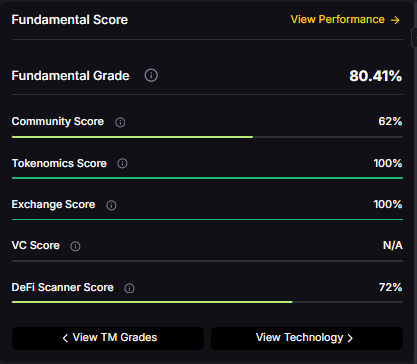
Technology Grade: 29.63% (Activity 22%, Repository 70%, Collaboration 48%, Security —, DeFi Scanner 72%).
Can BCH reach $3,000?
Based on the scenarios, BCH could reach $3,000 in the 23T moon case and 31T base case. The 23T tier projects $3,446.53 in the moon case. Not financial advice.
Can BCH 10x from current levels?
At current price of $553.54, a 10x would reach $5,535.40. This falls within the 31T base and moon cases. Bear in mind that 10x returns require substantial market cap expansion. Not financial advice.
Should I buy BCH now or wait?
Timing depends on your risk tolerance and macro outlook. Current price of $553.54 sits below the 8T bear case in our scenarios. Dollar-cost averaging may reduce timing risk. Not financial advice.
Want exposure? Buy BCH on MEXC
Disclosure
Educational purposes only, not financial advice. Crypto is volatile, do your own research and manage risk.
%201.svg)
%201.svg)
Infrastructure protocols become more valuable as the crypto ecosystem scales and relies on robust middleware. Chainlink provides critical oracle infrastructure where proven utility and deep integrations drive long-term value over retail speculation. Increasing institutional adoption raises demand for professional-grade data delivery and security.
Token Metrics projections for LINK below span multiple total market cap scenarios from conservative to aggressive. Each tier assumes different levels of infrastructure demand as crypto evolves from speculative markets to institutional-grade systems. These bands frame LINK's potential outcomes into 2027.

Disclosure
Educational purposes only, not financial advice. Crypto is volatile, do your own research and manage risk.
How to read it: Each band blends cycle analogues and market-cap share math with TA guardrails. Base assumes steady adoption and neutral or positive macro. Moon layers in a liquidity boom. Bear assumes muted flows and tighter liquidity.
TM Agent baseline: Token Metrics lead metric for Chainlink, cashtag $LINK, is a TM Grade of 23.31%, which translates to a Sell, and the trading signal is bearish, indicating short-term downward momentum. This means Token Metrics currently does not endorse $LINK as a long-term buy at current conditions.
Live details: Chainlink Token Details
Affiliate Disclosure: We may earn a commission from qualifying purchases made via this link, at no extra cost to you.
Token Metrics scenarios span four market cap tiers, each representing different levels of crypto market maturity and liquidity:
8T: At an 8 trillion dollar total crypto market cap, LINK projects to $26.10 in bear conditions, $30.65 in the base case, and $35.20 in bullish scenarios.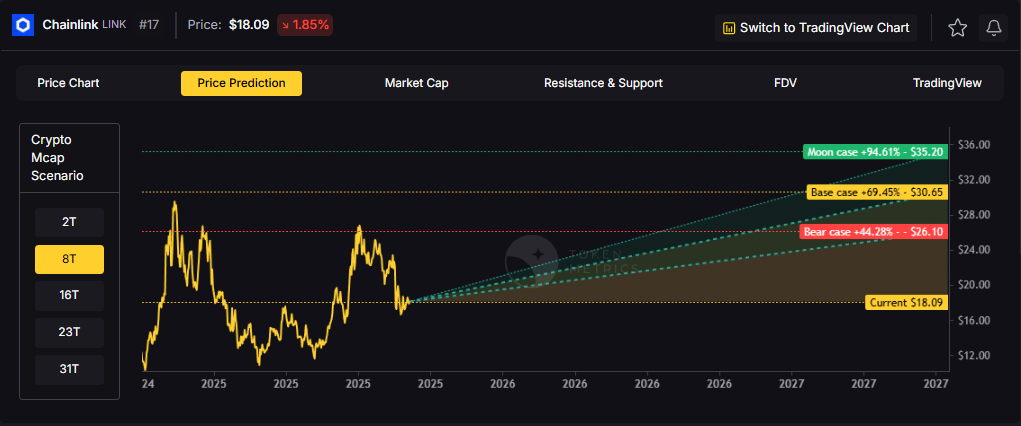
16T: Doubling the market to 16 trillion expands the range to $42.64 (bear), $56.29 (base), and $69.95 (moon).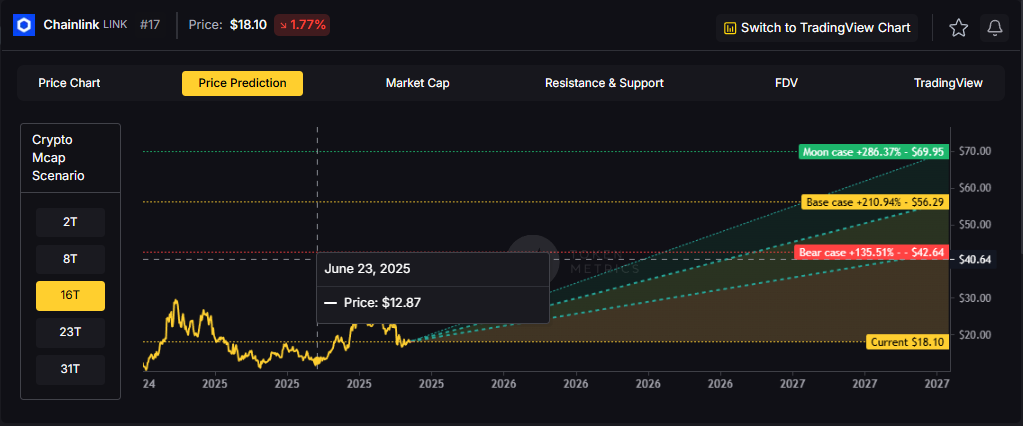
23T: At 23 trillion, the scenarios show $59.18, $81.94, and $104.70 respectively.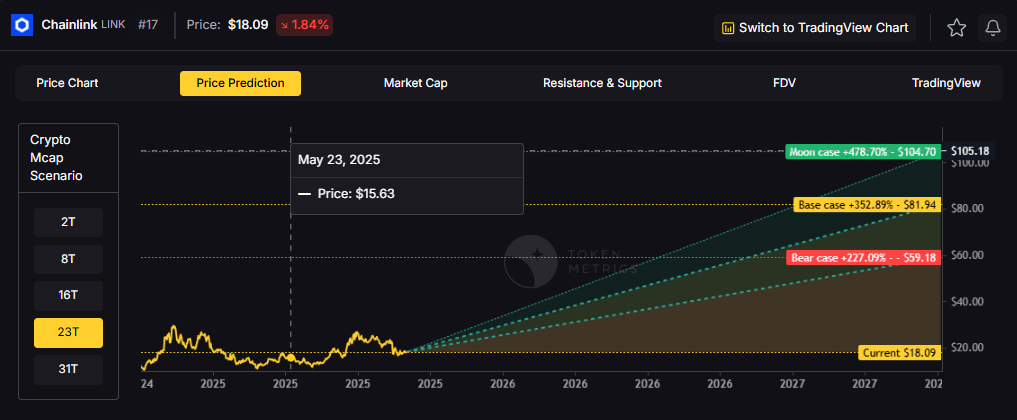
31T: In the maximum liquidity scenario of 31 trillion, LINK could reach $75.71 (bear), $107.58 (base), or $139.44 (moon).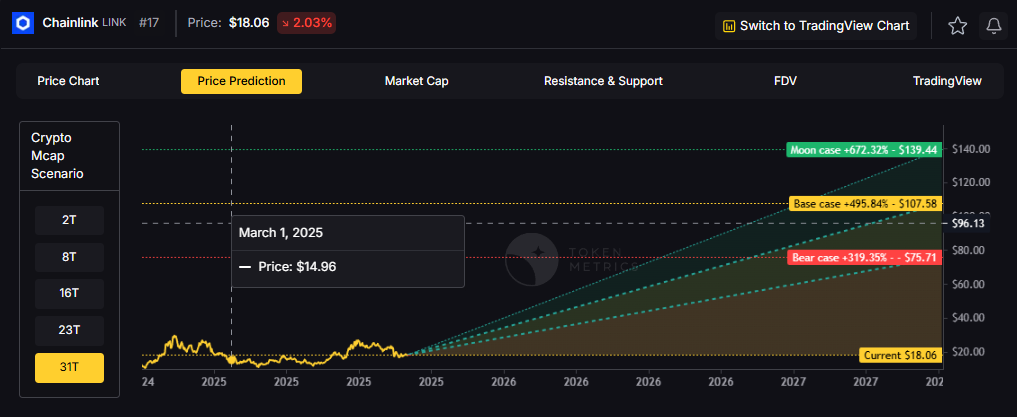
Chainlink represents one opportunity among hundreds in crypto markets. Token Metrics Indices bundle LINK with top one hundred assets for systematic exposure to the strongest projects. Single tokens face idiosyncratic risks that diversified baskets mitigate.
Historical index performance demonstrates the value of systematic diversification versus concentrated positions.
Chainlink is a decentralized oracle network that connects smart contracts to real-world data and systems. It enables secure retrieval and verification of off-chain information, supports computation, and integrates across multiple blockchains. As adoption grows, Chainlink serves as critical infrastructure for reliable data feeds and automation.
The LINK token is used to pay node operators and secure the network’s services. Common use cases include DeFi price feeds, insurance, and enterprise integrations, with CCIP extending cross-chain messaging and token transfers.
Vision: Chainlink aims to create a decentralized, secure, and reliable network for connecting smart contracts with real-world data and systems. Its vision is to become the standard for how blockchains interact with external environments, enabling trust-minimized automation across industries.
Problem: Smart contracts cannot natively access data outside their blockchain, limiting their functionality. Relying on centralized oracles introduces single points of failure and undermines the security and decentralization of blockchain applications. This creates a critical need for a trustless, tamper-proof way to bring real-world information onto blockchains.
Solution: Chainlink solves this by operating a decentralized network of node operators that fetch, aggregate, and deliver data from off-chain sources to smart contracts. It uses cryptographic proofs, reputation systems, and economic incentives to ensure data integrity. The network supports various data types and computation tasks, allowing developers to build complex, data-driven decentralized applications.
Market Analysis: Chainlink is a market leader in the oracle space and a key infrastructure component in the broader blockchain ecosystem, particularly within Ethereum and other smart contract platforms. It faces competition from emerging oracle networks like Band Protocol and API3, but maintains a strong first-mover advantage and widespread integration across DeFi, NFTs, and enterprise blockchain solutions. Adoption is driven by developer activity, partnerships with major blockchain projects, and demand for secure data feeds. Key risks include technological shifts, regulatory scrutiny on data providers, and execution challenges in scaling decentralized oracle networks. As smart contract usage grows, so does the potential for oracle services, positioning Chainlink at the center of a critical niche, though its success depends on maintaining security and decentralization over time.
Fundamental Grade: 74.58% (Community 81%, Tokenomics 100%, Exchange 100%, VC —, DeFi Scanner 17%).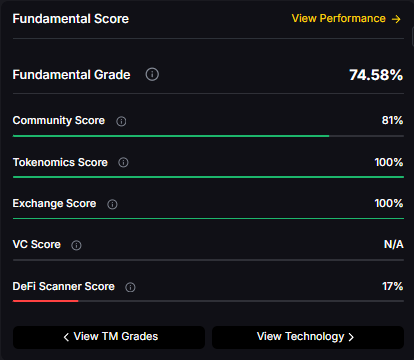
Technology Grade: 88.50% (Activity 81%, Repository 72%, Collaboration 100%, Security 86%, DeFi Scanner 17%).
Can LINK reach $100?
Yes. Based on the scenarios, LINK could reach $100+ in the 23T moon case. The 23T tier projects $104.70 in the moon case. Not financial advice.
What price could LINK reach in the moon case?
Moon case projections range from $35.20 at 8T to $139.44 at 31T. These scenarios assume maximum liquidity expansion and strong Chainlink adoption. Not financial advice.
Should I buy LINK now or wait?
Timing depends on risk tolerance and macro outlook. Current price of $18.09 sits below the 8T bear case in the scenarios. Dollar-cost averaging may reduce timing risk. Not financial advice.
Track live grades and signals: Token Details
Want exposure? Buy LINK on MEXC
Disclosure
Educational purposes only, not financial advice. Crypto is volatile, do your own research and manage risk.
Discover the full potential of your crypto research and portfolio management with Token Metrics. Our ratings combine AI-driven analytics, on-chain data, and decades of investing expertise—giving you the edge to navigate fast-changing markets. Try our platform to access scenario-based price targets, token grades, indices, and more for institutional and individual investors. Token Metrics is your research partner through every crypto market cycle.
%201.svg)
%201.svg)
The crypto market is tilting bullish into 2026 as liquidity, infrastructure, and participation improve across the board. Clearer rules and standards are reshaping the classic four-year cycle, flows can arrive earlier, and strength can persist longer than in prior expansions.
Institutional access is widening through ETFs and custody, while L2 scaling and real-world integrations help sustain on‑chain activity. This healthier backdrop frames our scenario work for HYPE. The ranges below reflect different total crypto market sizes and the share Hyperliquid could capture under each regime.
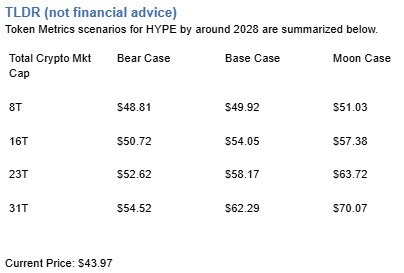
Disclosure
Educational purposes only, not financial advice. Crypto is volatile, do your own research and manage risk.
How to read it: Each band blends cycle analogues and market-cap share math with TA guardrails. Base assumes steady adoption and neutral or positive macro. Moon layers in a liquidity boom. Bear assumes muted flows and tighter liquidity.
TM Agent baseline: Token Metrics TM Grade is 73.9%, a Buy, and the trading signal is bearish, indicating short-term downward momentum. This means Token Metrics judges HYPE as fundamentally attractive over the long term, while near-term momentum is negative and may limit rallies.
Live details: Hyperliquid Token Details
Affiliate Disclosure: We may earn a commission from qualifying purchases made via this link, at no extra cost to you.
Scenario Analysis
Token Metrics scenarios span four market cap tiers, each representing different levels of crypto market maturity and liquidity:
8T: At an 8 trillion dollar total crypto market cap, HYPE projects to $48.81 in bear conditions, $49.92 in the base case, and $51.03 in bullish scenarios.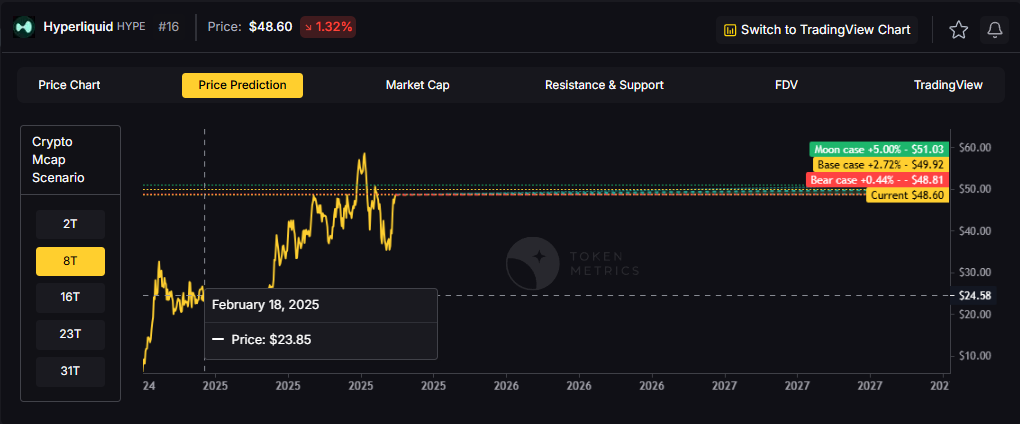
16T: Doubling the market to 16 trillion expands the range to $50.72 (bear), $54.05 (base), and $57.38 (moon).
23T: At 23 trillion, the scenarios show $52.62, $58.17, and $63.72 respectively.
31T: In the maximum liquidity scenario of 31 trillion, HYPE could reach $54.52 (bear), $62.29 (base), or $70.07 (moon).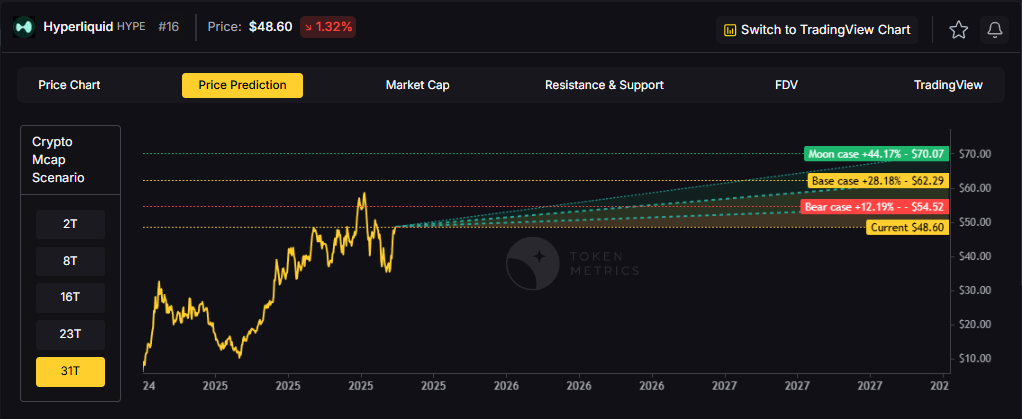
Each tier assumes progressively stronger market conditions, with the base case reflecting steady growth and the moon case requiring sustained bull market dynamics.
Diversification matters. HYPE is compelling, yet concentrated bets can be volatile. Token Metrics Indices hold HYPE alongside the top one hundred tokens for broad exposure to leaders and emerging winners.
Our backtests indicate that owning the full market with diversified indices has historically outperformed both the total market and Bitcoin in many regimes due to diversification and rotation.
Hyperliquid is a decentralized exchange focused on perpetual futures with a high-performance order book architecture. The project emphasizes low-latency trading, risk controls, and capital efficiency aimed at professional and retail derivatives traders. Its token, HYPE, is used for ecosystem incentives and governance-related utilities.
Can HYPE reach $60?
Yes, the 23T and 31T tiers imply ranges above $60 in the Base and Moon bands, though outcomes depend on liquidity and adoption. Not financial advice.
Is HYPE a good long-term investment?
Outcome depends on adoption, liquidity regime, competition, and supply dynamics. Diversify and size positions responsibly.
Disclosure
Educational purposes only, not financial advice. Crypto is volatile, do your own research and manage risk.
Token Metrics delivers AI-based crypto ratings, scenario projections, and portfolio tools so you can make smarter decisions. Discover real-time analytics on Token Metrics.

%201.svg)
%201.svg)
In the evolving world of Web3 development, the need for real-time, reliable, and institutional-grade crypto data has never been greater. Whether you’re building decentralized trading bots, DeFi apps, or smart contract platforms, accessing powerful off-chain data is key to creating intelligent and profitable on-chain systems.
That’s where the Token Metrics Crypto API comes in.
In this guide, we’ll walk you through how to integrate the Token Metrics API with Chainlink Functions, enabling you to deploy live smart contracts that interact with real-time crypto signals, token prices, and trader grades. You’ll learn how to use more than 20 API endpoints and smart contract adapters to power decentralized apps with actionable data.
If you’re searching for the best crypto API for smart contract development, or you need a free crypto API to start testing on testnets, this article is your ultimate resource.
The Token Metrics API is an advanced data interface designed for traders, developers, and Web3 builders. It provides access to over 20 endpoints covering everything from:
Built by a team of quant analysts, machine learning engineers, and crypto-native researchers, the Token Metrics Crypto API brings hedge-fund-grade intelligence into the hands of everyday builders.
Chainlink Functions enable smart contracts to securely retrieve off-chain data from any API. By integrating with the Token Metrics Crypto API, you can bridge institutional-grade analytics into fully decentralized apps—something not possible with basic or unreliable data sources.
Here’s why this combo is so powerful:
This integration enables the creation of intelligent trading bots, dynamic token allocations, and governance proposals backed by hard data—not speculation.
Let’s walk through how to connect the best crypto API—Token Metrics—with Chainlink Functions to build and deploy a live smart contract.
Start by cloning the GitHub repository that contains the full codebase. This includes:
Each smart contract is tailored to one Token Metrics API endpoint—meaning you can plug and play any dataset, from prices to sentiment scores.
The README provides a full list of recommended environment variables, including:
Once your .env is ready, you can start compiling and deploying.
In this walkthrough, the developer built a Solidity smart contract that:
The contract is compiled in Remix IDE, connected via MetaMask (on testnet), and deployed using testnet ETH and LINK tokens.
After deployment, you’ll receive a contract address that can be added to your Chainlink subscription.
To fund your contract for data requests:
This allows your contract to make external data calls using Chainlink’s decentralized oracle network.
Using the provided JavaScript scripts, you can interact with the smart contract and test data flow:
In the demo, the bot received a bullish signal, saw that the grade was high, and executed a buy trade accordingly. This logic can be expanded into full-scale trading strategies, rebalancing rules, or even on-chain governance triggers.
Here’s what makes the Token Metrics Crypto API the best crypto API for building advanced, data-driven dApps:
Get access to proprietary AI trading signals, used by hedge funds and institutional desks.
Whether you need sentiment data, grades, price trends, or quant models, it’s all there.
The data is not just live—it’s tested. Token Metrics backtests every signal against market conditions.
Pre-built smart contract adapters make it easy to use the API in Chainlink, Remix, or any EVM-compatible environment.
Start testing on testnets with a free crypto API key. Upgrade later for full production access.
Here are some examples of what you can build using this integration:
As Web3 matures, the ability to combine decentralized execution with centralized intelligence will define the next generation of dApps. The integration of Token Metrics Crypto API with Chainlink Functions is a major step in that direction.
Developers can now build on-chain applications that make smarter, faster, and more profitable decisions—powered by data that was once out of reach.
Whether you're a DeFi developer, a DAO engineer, or just exploring your first smart contract, this setup gives you a free crypto API to experiment with and the power of the best crypto API when you're ready to scale.
Your next-generation crypto trading bot starts here.

%201.svg)
%201.svg)
Moonshot investing in crypto is a double-edged sword. On one side, you have tokens that can 10x, 50x, or even 100x your portfolio. On the other side? Complete capital loss. While these asymmetric bets can lead to explosive profits, they also carry extreme risk—especially for uninformed or impulsive investors.
This guide will break down the risk landscape of moonshots: what makes them so volatile, common pitfalls to avoid, risk management strategies, and how tools like Token Metrics help reduce blind spots when betting on the next big thing.
Moonshots live in the outer rim of the crypto market. They are typically:
These factors create an environment where price moves fast—but fundamentals are often thin. You're betting more on potential than proof.

You must assume every moonshot has some of these risk factors — and plan accordingly.

Moonshots = high variance. Don’t treat them like stable assets.

If you answer “no” to 2 or more of these, tread cautiously.
Token Metrics helps de-risk moonshots by analyzing over 80+ data points using AI and quant models:
You get a comprehensive view of upside and downside before making a decision.
Moonshot investing is mental warfare. Stick to frameworks, not FOMO.
The path to 100x gains in crypto will always be riddled with landmines. But risk isn’t inherently bad — it’s the price of asymmetric upside. The real danger is unmanaged risk, impulsive decisions, and poor research.
With the right approach, the right tools, and a clear head, moonshot investing can be one of the most rewarding strategies in crypto.
Just remember: You only need to be right once.

%201.svg)
%201.svg)
When most people think “moonshot” in crypto, they think of meme coins like Dogecoin, Shiba Inu, or Pepe — volatile, viral, and often with no utility. While it’s true that meme coins have historically delivered explosive returns, they’re just one type of moonshot. In reality, some of the best moonshots are deeply technical projects with innovative real-world use cases.
In this blog, we’ll explore why moonshots go far beyond memes, the other types of high-potential assets you should be watching, and how to distinguish hype from substance in your moonshot hunt.
Meme coins dominate headlines and retail attention for good reason:
Because of these qualities, meme coins are often perceived as the only moonshots. But perception doesn’t equal reality.
Some of the most successful moonshot investments didn’t begin as memes — they were innovative, under-the-radar projects that grew into billion-dollar ecosystems:

None of these were memes — they were tech-focused moonshots.
Here are several non-meme sectors producing moonshot-level gains:
These projects combine visionary ideas with real-world applicability — and many began as stealth moonshots before going mainstream.
Look for:
Meme coins may be powered by emotion — but utility moonshots are powered by execution.
Token Metrics doesn’t just chase hype — it grades thousands of tokens using 80+ data points including:
This means you can discover both emerging meme coins and tech-driven moonshots based on real metrics — not just Twitter noise.
Yes — but they should be treated like short-term plays with proper risk management. When timed right (early launch, CEX rumor, meme trend), meme coins can 10x fast. But unlike utility tokens, meme coins often lack long-term sustainability unless they evolve (like DogeX or SHIB ecosystem).
Use tools like Token Metrics AI Signals to time entries and exits.

Don’t confuse “meme” with “momentum.” Use data.
If your moonshot portfolio is 100% meme coins, you're gambling. If it’s 100% early L1s with no traction, you may be stuck waiting years. Smart investors build a balanced basket that includes:
Meme coins are just one path to the moon — don’t miss the others.

%201.svg)
%201.svg)
Everyone wants to catch the next 100x token before it explodes. The real trick isn’t riding the hype — it’s getting in before the hype begins. That’s where the real alpha is. Early entry into promising crypto moonshots gives you a massive edge, but how do you consistently find these hidden gems before they go viral?
This guide breaks down where early-stage opportunities hide, what tools to use, and how smart investors separate real moonshots from noise.
Being early doesn’t mean buying after it’s on Coinbase or featured by YouTubers. It means:
Getting in early usually involves doing the work—but tools and tactics can help.
The fastest-moving crypto intelligence hub. Look for:
These platforms often list early-stage projects before they go mainstream:
Subreddits like r/cryptomoonshots and r/AltcoinDiscussion are full of degens sniffing out new coins. Just beware of shills.
Private Discords like Token Metrics or paid alpha communities provide filtered insights from experts.
The Token Metrics AI tools analyze thousands of tokens and surfaces early movers based on:

If it checks 3–5 of these boxes and you’re early? It might be worth a bet.
Watch out for these signals across Twitter, Telegram, and DEX listings:
Example: If you see a project listed on GeckoTerminal, surging in volume, mentioned in a Token Metrics Bullish Signal — that’s a sign to dig deeper.
Combine tools to validate your picks from multiple angles.

Let’s say you spotted Bonk (BONK) on Solana in December 2022:
If you got in pre-hype, your 10x to 50x gains were very possible.
Even if you’re early, avoid traps:
Early doesn’t always mean safe. Do your due diligence.
With the Token Metrics platform, you can:
That’s how you go from guessing to investing.
In crypto, timing is everything. If you can consistently find promising moonshots before they hit the mainstream, the upside is massive. But it takes strategy, tools, and a data-first mindset.
By combining on-chain signals, AI analysis, narrative momentum, and community validation, you can sharpen your edge — and maybe catch the next Shiba, Pepe, or Solana before the crowd.

%201.svg)
%201.svg)
In the fast-paced world of cryptocurrency, a “moonshot” refers to a crypto project or token that has the potential to achieve explosive, exponential gains — often 10x, 50x, or even 100x returns. The term originates from the phrase “to the moon,” a popular crypto meme used when the price of a coin skyrockets. Moonshots are speculative plays, typically centered around new, low market-cap projects that haven’t yet caught the mainstream’s attention.
While the rewards can be life-changing, the risks are equally significant. In this guide, we’ll explore what makes a crypto asset a moonshot, how to spot one early, the risk/reward tradeoff, and how you can approach moonshots like a pro.
A moonshot crypto token isn’t just any new coin — it’s one with specific characteristics that make it ripe for explosive growth, including:
In short, moonshots are asymmetric bets. You risk a small amount for the chance of a massive return.
Moonshots appeal to both degens and visionary investors alike for one key reason: life-changing upside. A $1,000 investment in a 100x coin could turn into $100,000. That level of ROI is hard to find in any other asset class.
And unlike large-cap coins like Bitcoin or Ethereum, where double-digit gains are celebrated, moonshots are expected to multiply in value several times over — often within months.
For all their upside, moonshots come with steep risks:
Many moonshot projects don’t have sustainable business models, and some may never deliver a product. That’s why proper research and risk management are essential.
Here are a few historical examples of coins that were considered moonshots before they exploded:
Each of these projects had early believers who saw the potential before the crowd caught on.
Here are key areas to assess when evaluating a potential moonshot:

Pro tip: Use tools like Token Metrics AI Grades to scan hundreds of low-cap tokens and detect promising moonshots early using data-driven metrics.

If you’re a long-term investor, moonshots should make up only a small percentage of your portfolio.
Moonshots are all about timing. Catching a token before it gets listed on major exchanges or gains influencer exposure is key. Once the herd finds it, the 100x opportunity is usually gone.
Best times to enter include:
Only if you’re willing to lose what you invest. Moonshots are not for the faint of heart. They are ideal for small, high-risk allocations in your portfolio — think of them as lottery tickets with better odds, provided you do your homework.
To succeed in moonshot investing:
Moonshots are where fortunes are made and lost. While they offer some of the most exciting opportunities in crypto, they require discipline, deep research, and a healthy risk appetite. Whether you're looking to turn $500 into $50,000 or simply want to understand what drives explosive gains in the crypto space, moonshots are a critical concept to grasp.

%201.svg)
%201.svg)
With the explosion of cryptocurrencies, narratives, and sectors in 2025, the question for many investors is no longer should I invest in crypto—but how. For those looking for diversified, smart exposure, crypto indices have become the go-to option.
But what is the best crypto index in 2025?
In this guide, we’ll explore the top-performing crypto indices of the year, what makes them effective, and how to choose the best index for your goals—whether you want passive exposure, thematic investing, or AI-powered optimization.
Before naming names, it’s important to understand the criteria that define a top crypto index:
Returns compared to BTC, ETH, and market benchmarks
Ability to avoid deep drawdowns and protect capital
Exposure to emerging trends like AI, Memecoins, RWA, or DeFi
How frequently and intelligently the index adjusts
Ease of investing, transparency, and platform reliability
Here are the top crypto indices dominating investor attention in 2025:
Type: AI-Powered
Strategy: Weekly dynamic rebalancing
Constituents: DOGE, SHIB, PEPE, WIF, BONK, FLOKI
Why It’s a Top Pick:
Memecoins dominated the first half of 2025. This AI-managed index captured upside by reallocating into trending tokens and exiting early during corrections. While risky, its weekly AI signals helped outperform most passive strategies.
Ideal For:
High-risk, high-reward investors looking to ride viral trends with smart protection.
Type: AI-Powered
Strategy: Bullish/bearish signals per token
Constituents: AAVE, UNI, LDO, RUNE, GMX, DYDX
Why It’s a Top Pick:
DeFi remains a foundational sector. The AI DeFi Index adapts to fast-changing liquidity trends and trading volumes. It reduces exposure to underperformers and increases weight in strong, breakout tokens.
Ideal For:
Long-term crypto believers who want smarter DeFi exposure with reduced risk.
Type: Market Cap Passive
Strategy: Holds top 10 coins by market cap
Constituents: BTC, ETH, SOL, BNB, ADA, etc.
Why It’s a Top Pick:
For conservative investors or institutions, Bitwise offers a simple, regulated way to get exposure to the largest digital assets. While it doesn’t capture emerging trends, it offers long-term stability.
Ideal For:
Traditional investors and institutions entering crypto via regulated vehicles.
Type: AI-Powered
Strategy: Thematic with dynamic risk adjustment
Constituents: MKR, ONDO, XDC, POLYX, CFG
Why It’s a Top Pick:
The Real World Asset narrative surged in 2025, driven by tokenized treasuries and institutional adoption. This index captured the upside while avoiding the fluff.
Ideal For:
Investors looking for exposure to crypto’s real-world utility and stable growth themes.
Type: Passive
Strategy: Weighted DeFi exposure
Constituents: AAVE, UNI, COMP, SNX, LRC
Why It’s a Top Pick:
One of the earliest thematic indices, DPI remains a favorite among DeFi-focused users who prefer full on-chain transparency and DAO governance.
Ideal For:
DeFi-native investors who want decentralized, trustless exposure.
The best crypto index isn’t universal—it depends on your risk tolerance, time horizon, and investment goals.
Here’s a breakdown:

Passive indices work well for long-term exposure to top tokens, but AI indices have outperformed in 2025 thanks to their ability to:
Platforms like Token Metrics offer weekly rebalanced AI indices that are tuned to market momentum, sentiment, and volatility.

Note: Returns are hypothetical and reflect aggregated performance snapshots.
The best crypto index in 2025 is the one that aligns with your goals and risk profile.
Crypto indices take the guesswork out of investing, allowing you to benefit from market trends without managing dozens of individual tokens.

%201.svg)
%201.svg)
The crypto market in 2025 is more advanced, more crowded, and more volatile than ever before. Thousands of tokens compete for attention, and prices can move dramatically in hours. For many investors—especially those who want to participate without day-trading—crypto index investing is the smartest and simplest way to grow wealth in the digital asset space.
But what exactly are the benefits of investing in a crypto index?
In this article, we’ll walk through the major advantages of crypto index investing—especially compared to picking individual tokens—and explain why more investors are turning to indices for long-term success.
A crypto index is a curated portfolio of cryptocurrencies bundled together to represent a market segment, investment strategy, or theme. It works just like an index fund or ETF in traditional finance—except it’s built for the crypto world.
Popular types of indices include:
Perhaps the biggest benefit of a crypto index is built-in diversification. Instead of betting on a single token, you gain exposure to multiple assets at once.
This spreads your risk. If one token underperforms or crashes, others in the basket can offset the loss—making your portfolio more resilient.
Example:
A DeFi Index might hold AAVE, UNI, LDO, and GMX. If UNI struggles, strong performance from LDO or GMX could still deliver overall gains.
Crypto can be complex—new tokens launch daily, narratives shift, and technical analysis isn’t for everyone.
Indices simplify your decision-making. You don’t need to constantly:
Instead, you choose an index that fits your goals, invest once, and let the structure handle the rest.
Most crypto indices rebalance automatically—meaning they adjust the weights of the tokens in the basket based on performance, market cap, or AI-generated signals.
Rebalancing helps:
For example, Token Metrics AI Indices rebalance weekly based on 80+ data points per token, including volatility, momentum, and sentiment.
Crypto moves in narratives: AI, Memecoins, Real World Assets (RWA), Gaming, and more. Sector-based indices allow you to invest in these narratives without trying to guess which token will lead the trend.
Want to ride the AI boom? Buy an AI Tokens Index.
Want exposure to new L1 blockchains? Choose a Layer 1 Index.
Thematic investing through indices is one of the most effective ways to align with where capital is flowing.
Individual tokens can be incredibly volatile—and if you choose the wrong one, your entire investment may collapse.
Indices smooth out volatility by combining multiple tokens. While the overall market is still risky, your exposure is far more controlled.
AI-powered indices go even further by:
This is dynamic risk management, not just passive exposure.
Let’s face it—crypto investors are often their own worst enemies.
Index investing removes these human emotions. Your portfolio follows rules, not feelings. Whether it’s a passive index or an AI-managed one, you gain disciplined, unemotional investing.
Crypto indices are now easier than ever to access. Most platforms allow you to start investing with as little as $50 to $100.
Depending on the platform, you can:
This makes crypto indexing ideal for beginners, busy professionals, and even institutions.
Passive indices offer simplicity and safety. But if you want to outperform the market, AI-powered indices give you an edge.
Token Metrics AI Indices, for example:
In 2024 and early 2025, many AI indices beat market cap indices by double-digit margins—especially during volatile market phases.
Let’s say you want to invest in DeFi but don’t know which tokens to pick.
You choose the Token Metrics AI DeFi Index. It currently includes:
Each week, it checks market signals. If LDO looks weak, the index might reduce exposure and allocate more to DYDX. If the entire market looks bearish, it might reduce risk by shifting into USDC.
You don’t need to lift a finger—but your portfolio stays optimized.

Whether you're new to crypto or looking to upgrade your portfolio strategy, crypto indices offer unmatched benefits in 2025:
Platforms like Token Metrics offer next-generation AI-driven indices tailored to your goals, helping you grow your portfolio while reducing the stress of crypto investing.
If you want to participate in crypto’s upside without constantly worrying about the downside, crypto indices are your best bet.

%201.svg)
%201.svg)
The world of crypto investing is known for its high risk and high reward. With extreme price swings, rug pulls, and market crashes, it’s no surprise that many investors are looking for safer ways to participate in the crypto market. One such method gaining popularity in 2025 is investing in crypto indices.
But how safe is investing in a crypto index?
In this article, we’ll explore the risks and benefits of crypto index investing, compare it to other strategies like trading individual tokens, and help you understand what “safe” really means in the context of crypto.
A crypto index is a curated basket of cryptocurrencies designed to track the performance of a specific segment of the market. Indices can be based on market cap (e.g., Top 10), themes (e.g., DeFi, AI, Memecoins), or even powered by AI that adjusts the portfolio based on market signals.
Rather than investing in a single token, you gain diversified exposure across multiple tokens—similar to how mutual funds or ETFs work in traditional finance.
By holding multiple assets, a crypto index spreads out the risk. If one token collapses, others in the basket may still perform well—minimizing portfolio damage.
Example:
If your Memecoin Index includes DOGE, SHIB, PEPE, and WIF, and one crashes, the others may rise, balancing your returns.
Many investors lose money by panic selling, FOMO buying, or making emotional trades. Indices are rule-based or AI-driven—removing emotion from the equation.
AI-powered indices, like those from Token Metrics, automatically rebalance based on data, not gut feelings.
While no crypto product is immune to volatility, AI-managed indices can exit positions in bear markets or shift capital into stablecoins when risk signals appear.
This dynamic risk management offers better downside protection than static HODL strategies.
Index criteria often exclude low-liquidity or high-risk assets. Most indices include tokens with:
This filters out scams or dead projects.
Absolutely not. There is no such thing as a risk-free investment in crypto. Here are the real risks to be aware of when investing in indices:
Crypto indices still follow the broader market. If Bitcoin and Ethereum crash, most indices will drop too—especially those based on market cap.
If you're investing in on-chain, tokenized indices (e.g., via Phuture or Index Coop), you’re relying on smart contracts. Bugs, exploits, or hacks are possible.
Some indices have poor construction—wrong weighting, bad rebalancing logic, or flawed token selection. Always review the index methodology.
If the platform offering the index is centralized and shuts down, your access to the portfolio may be impacted. Choose reputable, audited platforms like Token Metrics or Bitwise.

AI indices may provide better protection in volatile markets, as they can:
Token Metrics AI Indices, for example, are updated weekly based on 20+ data points per token.

Crypto indices strike a balance between control, risk management, and simplicity. They reduce your chance of making bad trades while still giving you exposure to market growth.
Crypto indices are ideal for beginners. You don’t need to understand complex tokenomics or track every coin. Just pick a theme, invest, and let the index do the work.
If you want long-term exposure without daily management, indices (especially market cap-based) are safer than trading.
Even advanced traders use indices to hedge risk or allocate a portion of their capital to automated strategies.
During a recent correction, the Token Metrics AI DeFi Index:
This kind of AI-driven risk management is where the future of safe investing lies.
While no investment is truly “safe” in crypto, crypto index investing significantly reduces your risk compared to individual token trading.
You gain:
If safety is your concern—but you still want to grow your wealth in crypto—start with a well-built index. For the most intelligent protection, explore AI-powered indices like those from Token Metrics, which automatically adjust to market conditions and help reduce risk dynamically.

%201.svg)
%201.svg)
Crypto investing can be overwhelming. With thousands of tokens to choose from, rapidly shifting narratives, and volatile price swings, even seasoned investors struggle to build and manage a balanced portfolio. That’s why crypto indices have become increasingly popular in 2025.
But how exactly does a crypto index work?
In this article, we’ll break down the mechanics of how crypto indices function, from token selection and weighting to rebalancing and performance tracking. By the end, you’ll understand how these powerful tools simplify crypto investing—and how you can take full advantage of them.
A crypto index is a structured portfolio of cryptocurrencies grouped together based on a common methodology. It represents a specific part of the market—such as the top 10 coins by market cap, the leading DeFi protocols, or trending tokens in a sector like AI or gaming.
Just like the S&P 500 tracks the performance of top U.S. companies, a crypto index tracks the collective performance of selected tokens.
Let’s explore how a typical crypto index operates step-by-step:
Every index starts with a set of criteria to determine which cryptocurrencies will be included.
The goal is to select a diversified set of tokens that represents the chosen segment of the market.
Once tokens are selected, the index must decide how much of each token to include.
Weighting determines how performance from each token impacts the overall index return.
Markets are always changing. Rebalancing is the process of adjusting the portfolio to maintain the target weights and remove underperforming assets.
Example:
If a memecoin in your index pumps and takes up 60% of the portfolio, rebalancing brings it back down to its intended 20%—locking in gains and reducing risk.
An index’s value is calculated based on the performance of its underlying assets and their respective weights.
The formula is similar to a weighted average return. For tokenized indices, the value is often represented as an Index Token Price.
Performance is typically measured:
Investors track these returns to compare index performance against benchmarks like Bitcoin or Ethereum.
To invest in an index, you typically:
Some platforms issue tokenized representations (ERC-20 index tokens), while others manage indices off-chain.
Let’s look at an AI-powered index on Token Metrics called the AI Tokens Index.
Outcome: Better risk-adjusted performance in volatile markets compared to static, passive indices.

Accurate pricing, volume, volatility, and liquidity data are critical for proper index functioning.
Manage token weights, execute trades, and handle rebalancing autonomously.
For AI or technical indices, algorithms analyze trends, patterns, and market signals to inform decisions.
Both exist.
In 2025, hybrid indices—that blend passive structure with active rebalancing—are becoming more popular.
Understanding how a crypto index works helps you make better investment decisions. You’ll know:
Crypto indices aren’t just simplified baskets—they are dynamic, data-driven tools that reflect the market in motion. Whether you choose a passive index or an AI-powered one, understanding the mechanics ensures you’re investing with clarity—not blind trust.
For smarter, automated exposure to the crypto market, consider using platforms like Token Metrics, which offer both passive HODL indices and advanced AI indices that rebalance weekly based on real market signals.


 Create Your Free Account
Create Your Free Account9450 SW Gemini Dr
PMB 59348
Beaverton, Oregon 97008-7105 US
.svg)




.png)
Token Metrics Media LLC is a regular publication of information, analysis, and commentary focused especially on blockchain technology and business, cryptocurrency, blockchain-based tokens, market trends, and trading strategies.
Token Metrics Media LLC does not provide individually tailored investment advice and does not take a subscriber’s or anyone’s personal circumstances into consideration when discussing investments; nor is Token Metrics Advisers LLC registered as an investment adviser or broker-dealer in any jurisdiction.
Information contained herein is not an offer or solicitation to buy, hold, or sell any security. The Token Metrics team has advised and invested in many blockchain companies. A complete list of their advisory roles and current holdings can be viewed here: https://tokenmetrics.com/disclosures.html/
Token Metrics Media LLC relies on information from various sources believed to be reliable, including clients and third parties, but cannot guarantee the accuracy and completeness of that information. Additionally, Token Metrics Media LLC does not provide tax advice, and investors are encouraged to consult with their personal tax advisors.
All investing involves risk, including the possible loss of money you invest, and past performance does not guarantee future performance. Ratings and price predictions are provided for informational and illustrative purposes, and may not reflect actual future performance.

